- Lower bout width: 12 5/8 inches
- Brazilian rosewood back and sides
- Ivory celluloid Bound fretboard
- Ivory celluloid Bound headstock
- Spruce top
- X braced
- Larson’s patented “built under tension” design
- Rosette: Abalone pearl and wood inlay bordering the sound hole
- Radiused ebony fingerboard, and Classic Larson Brothers’ “ebony below the binding”
- Engraved inlays on fretboard
- Original tuners
- Original ebony bridge
- Original bridge pins
- 1-7/8" wide nut
- 2 1/4" bridge string spacing
- 24.3" scale length
- One-piece mahogany neck, round C shaped neck profile.
-
Out of stock
 The Larson Brothers of Chicago never marketed any guitar, throughout their long career, that was marked “Larson”. Their designs were branded by Maurer, Stahl, Prairie State, Stetson, and a few other guitar makers– but never “Larson”. They were also known for making many “off-catalog” guitars, i.e. guitars with combinations of features that varied from the Maurer, Stahl, etc, catalogs, and guitars that were not marked at all with a brand. This guitar is a Larson Bros creation that is not marked at all. It is a custom made instrument–but it has all the typical Larson hallmarks. The tone of this Larson is every bit as wonderful as the Maurer/Larson listed above, indeed it is quite similar, due to the same patented “built under tension” design, and X-bracing. This Larson does not have laminated braces (it’s well documented that laminated braces were only used on certain models–and their use was not related to level or price.) Every part of this guitar is original, including original finish. There are two repaired cracks on the back, and three small, repaired cracks on top.
The Larson Brothers of Chicago never marketed any guitar, throughout their long career, that was marked “Larson”. Their designs were branded by Maurer, Stahl, Prairie State, Stetson, and a few other guitar makers– but never “Larson”. They were also known for making many “off-catalog” guitars, i.e. guitars with combinations of features that varied from the Maurer, Stahl, etc, catalogs, and guitars that were not marked at all with a brand. This guitar is a Larson Bros creation that is not marked at all. It is a custom made instrument–but it has all the typical Larson hallmarks. The tone of this Larson is every bit as wonderful as the Maurer/Larson listed above, indeed it is quite similar, due to the same patented “built under tension” design, and X-bracing. This Larson does not have laminated braces (it’s well documented that laminated braces were only used on certain models–and their use was not related to level or price.) Every part of this guitar is original, including original finish. There are two repaired cracks on the back, and three small, repaired cracks on top. -
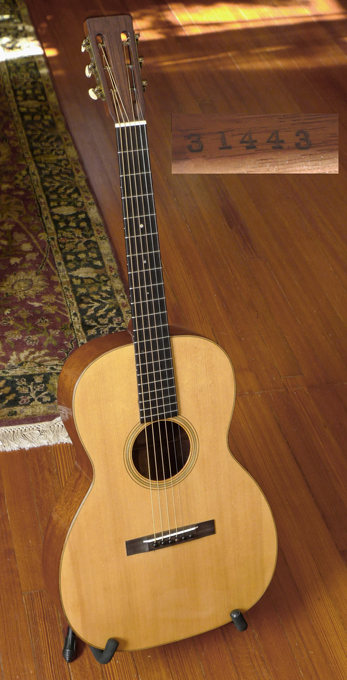 Long-scale, 000 sized 12-fret Martins from the late 20’s are among the most sought-after prewar instruments. This was the biggest, loudest Martin made for steel strings in this era, with a 25.4 inch scale length, the same scale length as a 30’s D-45. (The 14-fret 000’s of the 30s and later have a shorter, 24.5 inch scale). In no other instrument will you get the resonance (from thin tops and back), combined with the long scale length. It’s a big pre-war Martin 12-fret. That’s why this instrument is one of the most highly sought-after prewar Martins– and increasingly very difficult to find. But it’s all about one thing: the tone, emanating from a large-bodied 12-fret that plays wonderfully, and loud, even with the most delicate fingerpicking. The bass response here is the best you will ever find in any prewar Martin 12-fret guitar. This wonderful 000-18 was set up restored and set up by none other than Gruhn Guitars in Nashville– to impeccable standards. Gruhn refinished the top, back and sides. Neck, fretboard, headstock, are all original finish. Gruhn also replaced the bridge with a perfectly correct ebony bridge. The guitar has its original bridgeplate. New, period-correct Bar frets were installed by Gruhn. 1 7/8” nut. Mahogany back and sides. Adirondack spruce top. Ebony fingerboard. It has original tuners (gear wheel below worm gear, ivoroid buttons). The top and back of the guitar are completely crack-free and perfect– with full thickness the same as the day they left the factory. And the totally crack-free top shows absolutely perfect form and shape, with no undue bellying behind the bridge. There are a couple of almost imperceptible side cracks that were addressed by Gruhn, almost impossible to see from the outside. One of the most sought-after prewar Martin 12-frets, restored correctly, and set up, by the world’s best. (Included: a signed, in-hand Appraisal of the guitar– by George Gruhn)
Long-scale, 000 sized 12-fret Martins from the late 20’s are among the most sought-after prewar instruments. This was the biggest, loudest Martin made for steel strings in this era, with a 25.4 inch scale length, the same scale length as a 30’s D-45. (The 14-fret 000’s of the 30s and later have a shorter, 24.5 inch scale). In no other instrument will you get the resonance (from thin tops and back), combined with the long scale length. It’s a big pre-war Martin 12-fret. That’s why this instrument is one of the most highly sought-after prewar Martins– and increasingly very difficult to find. But it’s all about one thing: the tone, emanating from a large-bodied 12-fret that plays wonderfully, and loud, even with the most delicate fingerpicking. The bass response here is the best you will ever find in any prewar Martin 12-fret guitar. This wonderful 000-18 was set up restored and set up by none other than Gruhn Guitars in Nashville– to impeccable standards. Gruhn refinished the top, back and sides. Neck, fretboard, headstock, are all original finish. Gruhn also replaced the bridge with a perfectly correct ebony bridge. The guitar has its original bridgeplate. New, period-correct Bar frets were installed by Gruhn. 1 7/8” nut. Mahogany back and sides. Adirondack spruce top. Ebony fingerboard. It has original tuners (gear wheel below worm gear, ivoroid buttons). The top and back of the guitar are completely crack-free and perfect– with full thickness the same as the day they left the factory. And the totally crack-free top shows absolutely perfect form and shape, with no undue bellying behind the bridge. There are a couple of almost imperceptible side cracks that were addressed by Gruhn, almost impossible to see from the outside. One of the most sought-after prewar Martin 12-frets, restored correctly, and set up, by the world’s best. (Included: a signed, in-hand Appraisal of the guitar– by George Gruhn) -
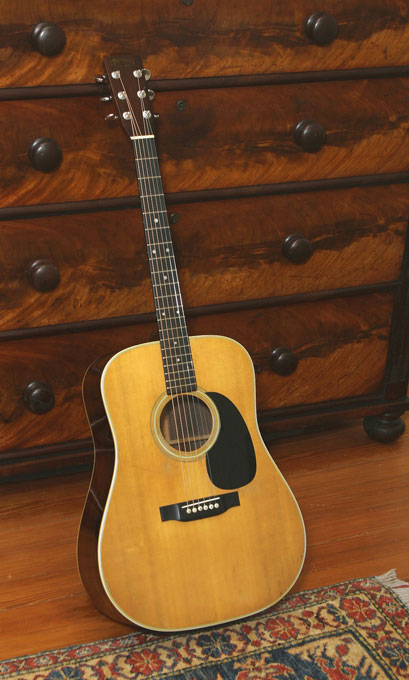 The last of the Mohicans, made within a few months before Martin stopped using Brazilian Rosewood on its instruments. Some guitars feel dead right the minute you pick them up. This is on of those. First and foremost, the tone of this instrument is unsurpassed for the bell-like trebles that only come from Brazilian Rosewood. The tone of this guitar, I would hold up to most mid-40’s D-28’s I’ve played. Playability, and set-up: it could not be better, and it’s got that 60’s combination of low action, great tuning speed and accuracy from the Grovers, and superb intonation all the way to the wee frets. More than anything, this guitar stands out for its low action combined with robust tone. Amazingly, the string height at the 12th fret: Just a hair over 2/32” at the high E; and 3/32 at the low E. It plays in our left hand like a dream, fast and fluid… yet the tone is full with no buzzing anywhere. I personally have never played a Martin dreadnought from any period that is so effortless to play, so easy on the left hand and so fast and yet so full of Brazilian tone. BTW, light gauge strings only? No way… I’ve got it strung with medium gauge, and it plays like butter in your left hand. Condition:
The last of the Mohicans, made within a few months before Martin stopped using Brazilian Rosewood on its instruments. Some guitars feel dead right the minute you pick them up. This is on of those. First and foremost, the tone of this instrument is unsurpassed for the bell-like trebles that only come from Brazilian Rosewood. The tone of this guitar, I would hold up to most mid-40’s D-28’s I’ve played. Playability, and set-up: it could not be better, and it’s got that 60’s combination of low action, great tuning speed and accuracy from the Grovers, and superb intonation all the way to the wee frets. More than anything, this guitar stands out for its low action combined with robust tone. Amazingly, the string height at the 12th fret: Just a hair over 2/32” at the high E; and 3/32 at the low E. It plays in our left hand like a dream, fast and fluid… yet the tone is full with no buzzing anywhere. I personally have never played a Martin dreadnought from any period that is so effortless to play, so easy on the left hand and so fast and yet so full of Brazilian tone. BTW, light gauge strings only? No way… I’ve got it strung with medium gauge, and it plays like butter in your left hand. Condition:- all original: finish; frets bridge, bridge plate, saddle. (Bridge pins could be replacements, hard to tell, but they are right.)
- The bridge looks like it has never been off
- Neck has never been set
- There is minor pickwear, with some moderate wear around the soundhole.
- No cracks on top; two, almost indiscernible cracks on back, that have been addressed–glued (no cleats). You have to look very hard to see these two back cracks, they are hairline cracks, each about 6 inches long.. but they are not visible from more than a few inches away, and impossible to photograph.
- Minor nicks and dings, most are visible in photos
- No strap lugs ever added
- Original end pin
- Throw away the book on this one… This is one of the best Brazilian rosewood Dreadnought Martins you’ll play, period, in fine original condition.
-
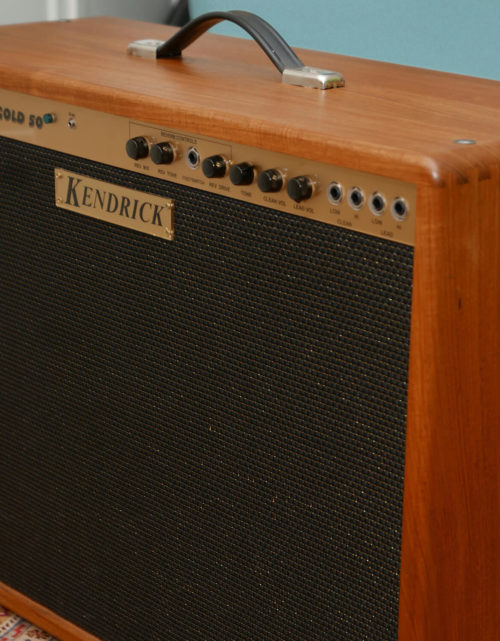 This was one of the best amps ever made by the legendary Gerald Weber. All-tube circuitry, designed and made in the USA, by Weber. It not only has power to spare (50 watts), but its unique circuitry has two channels, clean and lead, with different preamp circuit. These channels can be blended through patching the second input of one channel into the first input of the other, for purposes of blending the two channels together and further tone shaping with the interactive tone circuit. The bottom line: Tons of power if you need it, but the ability to get all the creamy, lush lead tones with the lead channel and/or blending. You just have to hear it. Original, handmade hardwood cabinet. 2 x 12: one 12 inch Kendrick brown frame and one 12 inch Kendrick black frame speaker. Kendrick's double spring reverb with three controls. Great condition. Recently serviced by one of the best amp techs in Texas. Price: $1495. No shipping. Local pickup only in Austin.
This was one of the best amps ever made by the legendary Gerald Weber. All-tube circuitry, designed and made in the USA, by Weber. It not only has power to spare (50 watts), but its unique circuitry has two channels, clean and lead, with different preamp circuit. These channels can be blended through patching the second input of one channel into the first input of the other, for purposes of blending the two channels together and further tone shaping with the interactive tone circuit. The bottom line: Tons of power if you need it, but the ability to get all the creamy, lush lead tones with the lead channel and/or blending. You just have to hear it. Original, handmade hardwood cabinet. 2 x 12: one 12 inch Kendrick brown frame and one 12 inch Kendrick black frame speaker. Kendrick's double spring reverb with three controls. Great condition. Recently serviced by one of the best amp techs in Texas. Price: $1495. No shipping. Local pickup only in Austin. -
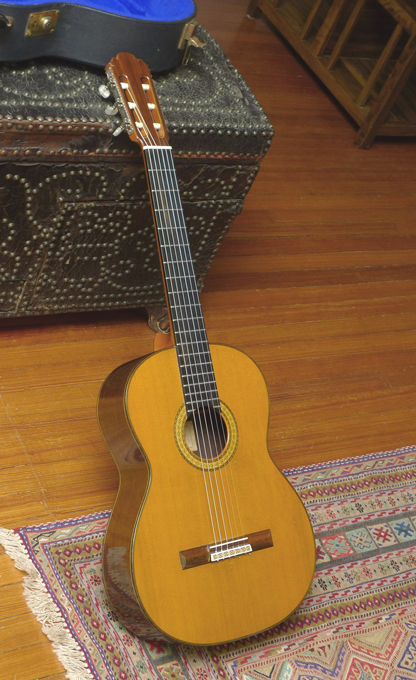 Another fine Kohno classical guitar from Masaru Kohno. This one combines a cedar top with Indian rosewood back and sides for a warm, clear tone. The best sounding Kohno 15 (or 20 for that matter) we’ve had.
Another fine Kohno classical guitar from Masaru Kohno. This one combines a cedar top with Indian rosewood back and sides for a warm, clear tone. The best sounding Kohno 15 (or 20 for that matter) we’ve had.- Cedar Top
- Indian Rosewood Back and sides
- Ebony Fretboard
- Deluxe Fustero tuners, with pearloid buttons
- Scale length: 660mm
- Nut: 52mm
- Condition is good. Several repaired cracks, all well-repaired:
- treble side, about 1/4 inch off fretboard: 3 2/3 inch
- bass side, 1 1/4 inch off fretboard: 4 ¼ inch
- 1/4 inch bass side of center seam, between bridge and soundhole: 4 inches
-
 We called it the “Tony Rice” prewar 000-18. Is it the "tony rice" style slightly enlarged soundhole (done decades ago). All original finish.
We called it the “Tony Rice” prewar 000-18. Is it the "tony rice" style slightly enlarged soundhole (done decades ago). All original finish. -
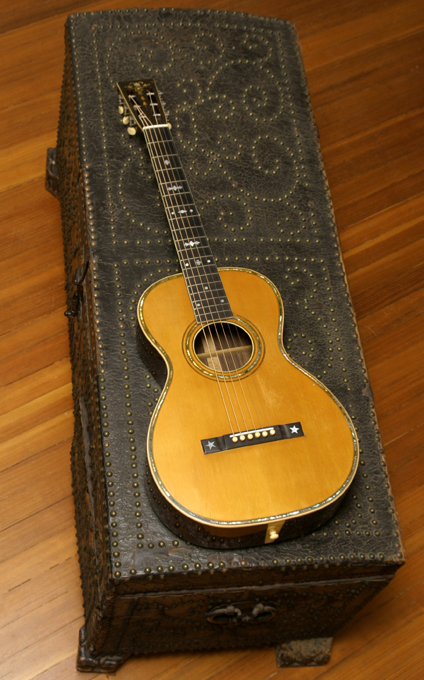 The Larson Brothers of Chicago began making steel string guitars earlier than did Martin, with their own ideas not tied to the past, and their designs are now considered by both players and collectors to be uniquely beautiful, wonderful for tone, and highly desirable. And they are much more rare guitars than Martin or Gibson– and more ornate than either Gibson or the always conservative Martin. Tone: think of a Martin Brazilian Rosewood 0-sized 12 fret from the 20’s, but add much more sustain. It vibrates in your hands, and because of Larson’s patented “built under tension” design, is thought of by players and collectors as being both unique and generating more sustain than you’ll get from any other guitar ever made. But the tone of Larsons (even the larger bodied-ones) is more treble-weighted than a Martin from the same era, so that this extra sustain does not result in a muddled sound– more like a magical shimmer and sustain that really brings out the mid- and treble-side Brazilian tone. Every part of this guitar is original. Guitar is crack-free. The bridge, never having been off the guitar, was at some point decades ago shaved slightly on top to lower the action. We have decided to keep this original bridge in place and not install a repro bridge–action is good, and the neck is straight. This particular model, is one of the very high end Larson models, with its Abalone trim, elaborate inlays on headstock and fretboard, and exquisite book-matched Brazilian rosewood back.
The Larson Brothers of Chicago began making steel string guitars earlier than did Martin, with their own ideas not tied to the past, and their designs are now considered by both players and collectors to be uniquely beautiful, wonderful for tone, and highly desirable. And they are much more rare guitars than Martin or Gibson– and more ornate than either Gibson or the always conservative Martin. Tone: think of a Martin Brazilian Rosewood 0-sized 12 fret from the 20’s, but add much more sustain. It vibrates in your hands, and because of Larson’s patented “built under tension” design, is thought of by players and collectors as being both unique and generating more sustain than you’ll get from any other guitar ever made. But the tone of Larsons (even the larger bodied-ones) is more treble-weighted than a Martin from the same era, so that this extra sustain does not result in a muddled sound– more like a magical shimmer and sustain that really brings out the mid- and treble-side Brazilian tone. Every part of this guitar is original. Guitar is crack-free. The bridge, never having been off the guitar, was at some point decades ago shaved slightly on top to lower the action. We have decided to keep this original bridge in place and not install a repro bridge–action is good, and the neck is straight. This particular model, is one of the very high end Larson models, with its Abalone trim, elaborate inlays on headstock and fretboard, and exquisite book-matched Brazilian rosewood back.- Year: 1926
- Model: 562
- Serial number: 31778
- This is the Maurer Larson Brothers “Standard size”: lower bout width: 12 3/4 inches
- Brazilian rosewood back and sides
- Spruce top
- Larson's “laminated” X braces. This is the patented Larson Brothers’ bracing, with each brace being Spruce/Rosewood/Spruce
- Larson’s patented “built under tension” design
- Trim: Abalone pearl and herringbone bordering the top and sound hole
- Torch-style pearl headstock inlay
- Radiused ebony fingerboard, and Classic Larson Brothers’ “ebony below the binding”
- Engraved inlays on fretboard
- Original Engraved Waverly tuners
- Original Ivory bridge pins
- 1-7/8" wide nut
- 2-5/16" bridge string spacing
- 24.5" scale length
- One-piece mahogany neck, round C shaped neck profile.
-
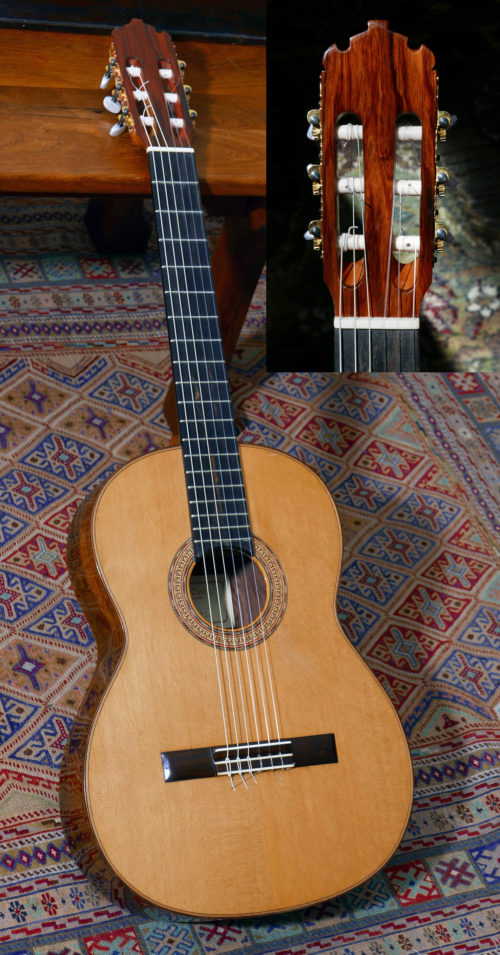 Acquired from the original owner – who bought this wonderful instrument directly from David Caro in the mountain town of the maker, one of the best luthiers that Paracho, Mexico has ever produced – in the mid 90’s and hand-carried it to California where it was lightly played. And it remains in remarkable original condition. The maker is David Caro, also known as David Caro Leonardo, or David Caro L. (In Mexico, the last/last name, in this case “Leonardo”, is the mother’s maiden name that is formally added after a person’s last [paternal] name but typically dropped in all but formal situations, documents etc.) Caro’s best instruments are among the best of a small, elite group that honed their craft at the top levels, and also benefited from visits and master classes given in Paracho by some world class luthiers from Spain, Germany, and the USA such as Felix Manzanero, Antonio Raya Pardo, Jose Romanillos, Thomas Humphery, and Herman Hauser III. Only a few Paracho luthiers have stood out over the years – Jose Navarro, Arturo Huipe, Abel Garcia, Enos Hernandez (his best work), German Vasquez Rubio, and Caro among them. See the enclosed photos from Fretboard Journal magazine, Spring 2008, that featured David Caro prominently in the feature article in that issue on Paracho luthiers. Paracho is an originally Tarascan village that sits in a high valley at 7,300 feet altitude, in the state of Michoacán, a relatively little visited state but renowned for its diversity and great beauty – and for some of the best classical guitar luthiers in the Americas. It extends from the Pacific coast, and is crossed by the Sierra Madre Del Sur in its southern part and by high volcanic mountains in its northern axis. When this guitar was made, in 1996, David Caro was at the height of his craft. And soon after, he was the first luthier to be added to the GSA calendar. This instrument is among the very best guitars ever made by Caro. And we love the model designation, it’s signed by hand on the label, “Mdo. 500”, i.e. “model 500” – sounds like a sports car name. Model 500 was the top model from Caro, in 1995/96 – using top woods, and also the best bindings, and all details. In those years, Caro’s best concert instruments went from model 100 at the base level, then ascending in tone woods and overall construction details to 200, 300, 400, then reaching the top level of “500”. So we’re calling this instrument, “el Quinientos”. (Spanish for “the 500” – nice ring to that – it’s pronounced “key-knee-éntose”) Several things make this guitar stand out as a gem: • It’s the top model from this luthier in the 1990’s • The great original condition • Scale length of 648mm. This scale length is reminiscent of Herman Hauser I’s guitars, and is firmly in the school of the shorter 650 range, not the longer scale lengths that crept in, in the last quarter of the 20th century. This is a great scale length – and note the nut width is a typical nut width of a full size classical guitar. And the neck thickness is great – on the thinner side. This combination makes it a joy to play and so easy to play – but the tone is superb. The full tone, and volume are better than most longer scale guitars. • Light weight/construction, that really allows it to sing. Its total weight, with strings, is a remarkably lithe 1430 grams • And it has great combination of woods: • Palo Escrito back and sides, bridge, and headplate veneer. DALBERGIA PALOESCRITO, is a true rosewood, a great wood that over the years came to be favored by the top luthiers in Paracho – for their top models. It sounds like Brazilian rosewood, but a tad different, and it’s not as “dark” in tone as Indian rosewood. Palo Escrito is lighter in weight and density than either brazilian or Indian rosewood. And weight, is of course part of the equation of a guitar that does translate to tone. Palo Escrito makes this guitar really breathe, and resonate. The lighter weight of this guitar is its charm, that translates to tone – slightly more airy and open, less “closed”, and with full round basses. The tone is clear, with superb string separation, as from the best spruce over rosewood guitars. Surprising volume – but it perhaps produces the best tone, in more delicate playing where you want each note to stand out – that’s of course called good “string separation”: the notes in a run or chord don’t all “blend together” but each note is discernable. And we think it’s accurate to say that this guitar, with its light weight and 648 scale length and combination of woods, has a tone that leans to a great Flamenco negra tone. Fast attack on the trebles, with a touch of growl in the bass when you play them hard. Yet the guitar responds very well to a light touch as well. If you’re looking for another ho-hum, non-descript spruce over Indian rosewood classical tone, this instrument is not for you. • Spruce top – European Alpine spruce • Ebony fingerboard • Ebony reinforcing strips, back of neck • Ebony heel cap • Beautiful rosette, with a hearts & rope pattern (another homage to Bernabe). • Palo Escrito is also used in the binding, back center strip, tie block, and purfling • The headstock shape is an homage to Paulino Bernabe. • Fan strutting, with 5 braces. The braces are very thin, and also scalloped – contributing to the great tone of the instrument. The scale length of the guitar, if it's not on the longer side, allows the luthier to be use more delicate bracing, adding to tone. (Longer scale length guitars produce more tension on the top due to the higher string tension inherent in a longer scale, so luthiers typically have to brace more strongly with longer scale lengths.) • And there is unique, 2-rosewood cleat application under the bridge – one cleat added by Caro at time of construction, on either end of the bridge, on the underside of top, for stability of the top wood beneath the bridge ends. It's worked well. • Good saddle height– and the neck is very straight, and there will never be any neck bowing issues or issue with too high action. Condition: 100% crack-free All original, thin lacquer finish Frets, and fretboard show very little wear A few nicks and dings, and a small amount of fingernail marks in the “pick guard” area. Overall, the condition is what you’d expect from an instrument that’s been played, carefully, for maybe a year, not 20+ years. But the tone is aged, open, clear – benefiting from more than two decades of aging and drying of the woods. Scale length: 648mm Nut Width: 52mm (2 2/32 inches) String spacing at nut: 45mm (1 ¾ inches) Width at lower bout: 14 ¼ inches Body depth, at bottom: 4 inches Body depth, at neck/body joint: 3 ¾ inches Weight (fully strung): 1430 grams (3.15 pounds) In a modern, hard shell case. Price: $4,750.
Acquired from the original owner – who bought this wonderful instrument directly from David Caro in the mountain town of the maker, one of the best luthiers that Paracho, Mexico has ever produced – in the mid 90’s and hand-carried it to California where it was lightly played. And it remains in remarkable original condition. The maker is David Caro, also known as David Caro Leonardo, or David Caro L. (In Mexico, the last/last name, in this case “Leonardo”, is the mother’s maiden name that is formally added after a person’s last [paternal] name but typically dropped in all but formal situations, documents etc.) Caro’s best instruments are among the best of a small, elite group that honed their craft at the top levels, and also benefited from visits and master classes given in Paracho by some world class luthiers from Spain, Germany, and the USA such as Felix Manzanero, Antonio Raya Pardo, Jose Romanillos, Thomas Humphery, and Herman Hauser III. Only a few Paracho luthiers have stood out over the years – Jose Navarro, Arturo Huipe, Abel Garcia, Enos Hernandez (his best work), German Vasquez Rubio, and Caro among them. See the enclosed photos from Fretboard Journal magazine, Spring 2008, that featured David Caro prominently in the feature article in that issue on Paracho luthiers. Paracho is an originally Tarascan village that sits in a high valley at 7,300 feet altitude, in the state of Michoacán, a relatively little visited state but renowned for its diversity and great beauty – and for some of the best classical guitar luthiers in the Americas. It extends from the Pacific coast, and is crossed by the Sierra Madre Del Sur in its southern part and by high volcanic mountains in its northern axis. When this guitar was made, in 1996, David Caro was at the height of his craft. And soon after, he was the first luthier to be added to the GSA calendar. This instrument is among the very best guitars ever made by Caro. And we love the model designation, it’s signed by hand on the label, “Mdo. 500”, i.e. “model 500” – sounds like a sports car name. Model 500 was the top model from Caro, in 1995/96 – using top woods, and also the best bindings, and all details. In those years, Caro’s best concert instruments went from model 100 at the base level, then ascending in tone woods and overall construction details to 200, 300, 400, then reaching the top level of “500”. So we’re calling this instrument, “el Quinientos”. (Spanish for “the 500” – nice ring to that – it’s pronounced “key-knee-éntose”) Several things make this guitar stand out as a gem: • It’s the top model from this luthier in the 1990’s • The great original condition • Scale length of 648mm. This scale length is reminiscent of Herman Hauser I’s guitars, and is firmly in the school of the shorter 650 range, not the longer scale lengths that crept in, in the last quarter of the 20th century. This is a great scale length – and note the nut width is a typical nut width of a full size classical guitar. And the neck thickness is great – on the thinner side. This combination makes it a joy to play and so easy to play – but the tone is superb. The full tone, and volume are better than most longer scale guitars. • Light weight/construction, that really allows it to sing. Its total weight, with strings, is a remarkably lithe 1430 grams • And it has great combination of woods: • Palo Escrito back and sides, bridge, and headplate veneer. DALBERGIA PALOESCRITO, is a true rosewood, a great wood that over the years came to be favored by the top luthiers in Paracho – for their top models. It sounds like Brazilian rosewood, but a tad different, and it’s not as “dark” in tone as Indian rosewood. Palo Escrito is lighter in weight and density than either brazilian or Indian rosewood. And weight, is of course part of the equation of a guitar that does translate to tone. Palo Escrito makes this guitar really breathe, and resonate. The lighter weight of this guitar is its charm, that translates to tone – slightly more airy and open, less “closed”, and with full round basses. The tone is clear, with superb string separation, as from the best spruce over rosewood guitars. Surprising volume – but it perhaps produces the best tone, in more delicate playing where you want each note to stand out – that’s of course called good “string separation”: the notes in a run or chord don’t all “blend together” but each note is discernable. And we think it’s accurate to say that this guitar, with its light weight and 648 scale length and combination of woods, has a tone that leans to a great Flamenco negra tone. Fast attack on the trebles, with a touch of growl in the bass when you play them hard. Yet the guitar responds very well to a light touch as well. If you’re looking for another ho-hum, non-descript spruce over Indian rosewood classical tone, this instrument is not for you. • Spruce top – European Alpine spruce • Ebony fingerboard • Ebony reinforcing strips, back of neck • Ebony heel cap • Beautiful rosette, with a hearts & rope pattern (another homage to Bernabe). • Palo Escrito is also used in the binding, back center strip, tie block, and purfling • The headstock shape is an homage to Paulino Bernabe. • Fan strutting, with 5 braces. The braces are very thin, and also scalloped – contributing to the great tone of the instrument. The scale length of the guitar, if it's not on the longer side, allows the luthier to be use more delicate bracing, adding to tone. (Longer scale length guitars produce more tension on the top due to the higher string tension inherent in a longer scale, so luthiers typically have to brace more strongly with longer scale lengths.) • And there is unique, 2-rosewood cleat application under the bridge – one cleat added by Caro at time of construction, on either end of the bridge, on the underside of top, for stability of the top wood beneath the bridge ends. It's worked well. • Good saddle height– and the neck is very straight, and there will never be any neck bowing issues or issue with too high action. Condition: 100% crack-free All original, thin lacquer finish Frets, and fretboard show very little wear A few nicks and dings, and a small amount of fingernail marks in the “pick guard” area. Overall, the condition is what you’d expect from an instrument that’s been played, carefully, for maybe a year, not 20+ years. But the tone is aged, open, clear – benefiting from more than two decades of aging and drying of the woods. Scale length: 648mm Nut Width: 52mm (2 2/32 inches) String spacing at nut: 45mm (1 ¾ inches) Width at lower bout: 14 ¼ inches Body depth, at bottom: 4 inches Body depth, at neck/body joint: 3 ¾ inches Weight (fully strung): 1430 grams (3.15 pounds) In a modern, hard shell case. Price: $4,750. -
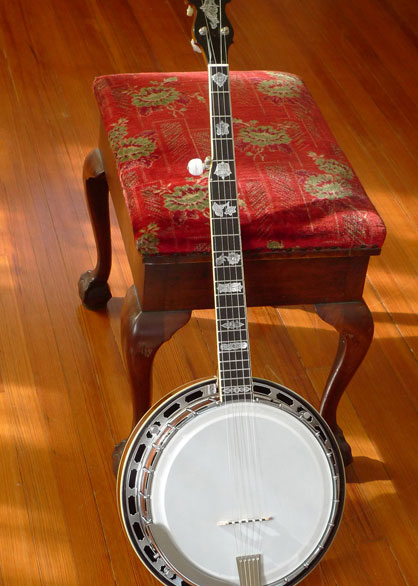 Late 1970s, but in almost unplayed condition. Bluegrass banjo players seek out these 70’s Whyte Eagles, known for their tone and craftsmanship. It was a pretty short window of only about five years, when these banjos were made with this kind of craftsmanship. They blow away most any banjo made and marketed (from any country) in the 60s, 70s and 80s– and they show no logos on headstock– just beautiful mother of pearl. It’s the No. 4310 “Whyte Eagle”. Based on late 1920’s Vega Griffin (Tubaphone #9) style inlays, with engraved, carved heel. Sunburst finish maple banjo, Gibson-style 2 piece flange, full height 20 hole archtop tone ring, dual coordinator rods, flamed maple resonator, maple neck, chrome finish. Neck is butterfly with ebony strip on back of neck, down the center. Just set up, with new tailpiece, and new head, by Dave Trexle and ready to play: loud, clear, and bright. With original hard shell case.
Late 1970s, but in almost unplayed condition. Bluegrass banjo players seek out these 70’s Whyte Eagles, known for their tone and craftsmanship. It was a pretty short window of only about five years, when these banjos were made with this kind of craftsmanship. They blow away most any banjo made and marketed (from any country) in the 60s, 70s and 80s– and they show no logos on headstock– just beautiful mother of pearl. It’s the No. 4310 “Whyte Eagle”. Based on late 1920’s Vega Griffin (Tubaphone #9) style inlays, with engraved, carved heel. Sunburst finish maple banjo, Gibson-style 2 piece flange, full height 20 hole archtop tone ring, dual coordinator rods, flamed maple resonator, maple neck, chrome finish. Neck is butterfly with ebony strip on back of neck, down the center. Just set up, with new tailpiece, and new head, by Dave Trexle and ready to play: loud, clear, and bright. With original hard shell case. -
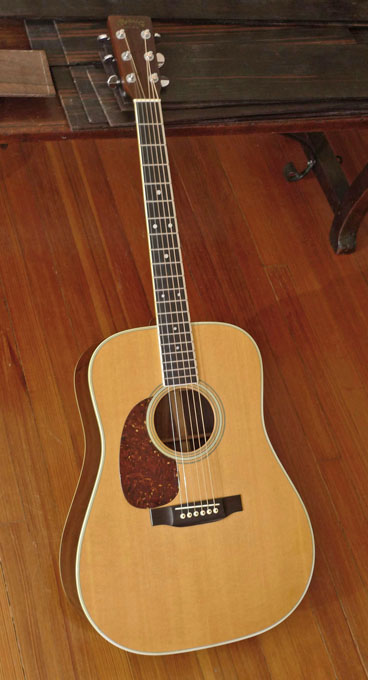 This is a wonderful, original from the factory "Lefty", a 1975 D-35L. Lefty's from this period are rare. Before the era of computerized factories, and the intro of the CNC machines at Martin, a high-end Lefty like this one was essentially a custom-made guitar. The bracing in this guitar was custom designed and built at the Martin factory for a true lefty top– this is not a regular D-35 with just different saddle and pickguard. It's built as a left-handed guitar, down to every brace. This guitar is in about as close to mint condition as you can get. The original black pickguard was lifting a bit (not from wear, there wasn't any– but just because Martin used some odd pickguard material in those years), so we just thought it would be cool to replace it with a vintage 30s style tortoise guard. I had John Allison cut a new guard, using period correct (1930's that is) nitrocellulose material. It looks great. (and BTW it's on the exact footprint of the original guard– they nudged them up a bit closer to the bridge on lefty's). This guitar sounds great. Fine, ringing trebles. Beautiful mids. It's one of the best D-35's we've played, from any period. And again, the condition is just almost mint. No cracks. No checking of finish. Everything except the pickguard is 100% original. It comes in its original hard shell Martin case, and original Martin literature from the Factory. The neck is straight, and action is perfect.
This is a wonderful, original from the factory "Lefty", a 1975 D-35L. Lefty's from this period are rare. Before the era of computerized factories, and the intro of the CNC machines at Martin, a high-end Lefty like this one was essentially a custom-made guitar. The bracing in this guitar was custom designed and built at the Martin factory for a true lefty top– this is not a regular D-35 with just different saddle and pickguard. It's built as a left-handed guitar, down to every brace. This guitar is in about as close to mint condition as you can get. The original black pickguard was lifting a bit (not from wear, there wasn't any– but just because Martin used some odd pickguard material in those years), so we just thought it would be cool to replace it with a vintage 30s style tortoise guard. I had John Allison cut a new guard, using period correct (1930's that is) nitrocellulose material. It looks great. (and BTW it's on the exact footprint of the original guard– they nudged them up a bit closer to the bridge on lefty's). This guitar sounds great. Fine, ringing trebles. Beautiful mids. It's one of the best D-35's we've played, from any period. And again, the condition is just almost mint. No cracks. No checking of finish. Everything except the pickguard is 100% original. It comes in its original hard shell Martin case, and original Martin literature from the Factory. The neck is straight, and action is perfect. -
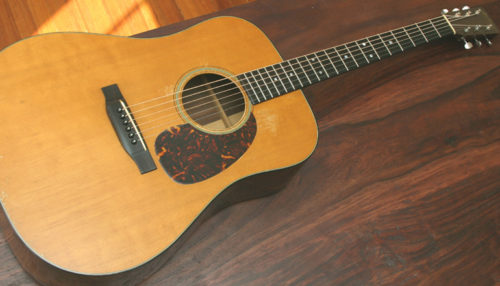 This big booming dreadnaught from one of Martin’s finest eras has everything you’d expect in volume, but it also has that wonderful sustain and ringing treble, and warm round bass, that only an almost-50-year-old Brazilian Rosewood Martin dreadnaught brings. All original throughout. Small 3 inch finish crack on lower back, stable. Typical B-string/pickguard crack, difficult to see, from bridge to beneath guard. Great original finish with minor dings and some minor pickwear around the soundhole. Ivory nut, full, original bridge and perfect condition maple bridge plate. The frets are in great condition. Rosewood fingerboard shows slight wear, nothing out of the ordinary. Frets are fine, showing minimal wear. Beautiful tortoiseshell binding in great condition, no separation anywhere. Inside of guitar shows all braces perfect–very clean and dust-free inside. Strap lug on heel and endpin. The neck was just set by Tony Nobles, and the action is low, with no buzzing. You can play it hard. It was fitted with a new bone saddle with the neck set (the original ivory saddle is in the case). Brazilian rosewood D-size Martins, from the era when Martin still used hide glue for guitar construction, are highly sought-after. This one, in this condition, will go quickly.
This big booming dreadnaught from one of Martin’s finest eras has everything you’d expect in volume, but it also has that wonderful sustain and ringing treble, and warm round bass, that only an almost-50-year-old Brazilian Rosewood Martin dreadnaught brings. All original throughout. Small 3 inch finish crack on lower back, stable. Typical B-string/pickguard crack, difficult to see, from bridge to beneath guard. Great original finish with minor dings and some minor pickwear around the soundhole. Ivory nut, full, original bridge and perfect condition maple bridge plate. The frets are in great condition. Rosewood fingerboard shows slight wear, nothing out of the ordinary. Frets are fine, showing minimal wear. Beautiful tortoiseshell binding in great condition, no separation anywhere. Inside of guitar shows all braces perfect–very clean and dust-free inside. Strap lug on heel and endpin. The neck was just set by Tony Nobles, and the action is low, with no buzzing. You can play it hard. It was fitted with a new bone saddle with the neck set (the original ivory saddle is in the case). Brazilian rosewood D-size Martins, from the era when Martin still used hide glue for guitar construction, are highly sought-after. This one, in this condition, will go quickly. -
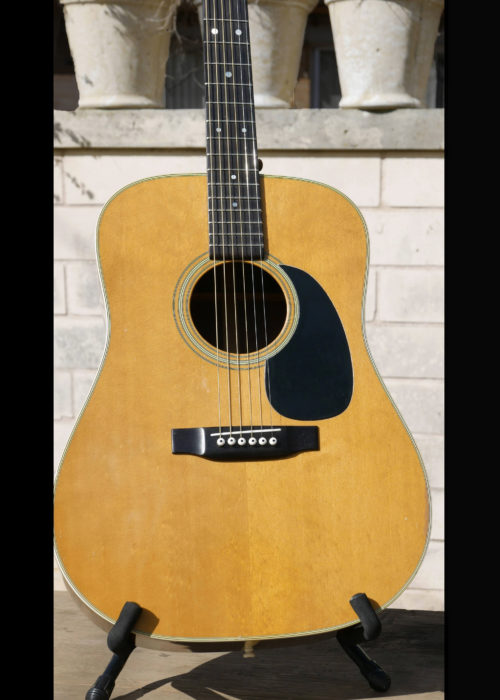 Many players consider the best Martin D-28’s from the 70’s great guitars– and the best value around if you want a vintage D-28 on a budget. The best ones deliver great tone– a darker, richer voice than 50's or 60’s D-28’s. The non-adjustable truss rod, and great Indian rosewood Martin used in those years, and the nice bear claw sitka on top on this example, all make for a lovely instrument. A few nicks and dings, but in remarkable original condition. This instrument delivers. It’s all original, and it’s 100% crack-free (not even the common “pickguard crack”). The original pickguard is not lifting as you often see on these Martins. Original bridge that's never been off the guitar, pins, everything. It has the typical slight finish crazing on top, visible from an angle– it’s common on this vintage. The neck has never been set. Frets in fine shape. Original Grovers. With a low-ish saddle, it plays fine. And in tune everywhere. At some point in the future the new owner may want to do a neck set, but we prefer to keep it all original (and the action is fine as is). ... no longer available – see the newly listed 1970 Martin D-28 in the Featured Instruments section.
Many players consider the best Martin D-28’s from the 70’s great guitars– and the best value around if you want a vintage D-28 on a budget. The best ones deliver great tone– a darker, richer voice than 50's or 60’s D-28’s. The non-adjustable truss rod, and great Indian rosewood Martin used in those years, and the nice bear claw sitka on top on this example, all make for a lovely instrument. A few nicks and dings, but in remarkable original condition. This instrument delivers. It’s all original, and it’s 100% crack-free (not even the common “pickguard crack”). The original pickguard is not lifting as you often see on these Martins. Original bridge that's never been off the guitar, pins, everything. It has the typical slight finish crazing on top, visible from an angle– it’s common on this vintage. The neck has never been set. Frets in fine shape. Original Grovers. With a low-ish saddle, it plays fine. And in tune everywhere. At some point in the future the new owner may want to do a neck set, but we prefer to keep it all original (and the action is fine as is). ... no longer available – see the newly listed 1970 Martin D-28 in the Featured Instruments section. -
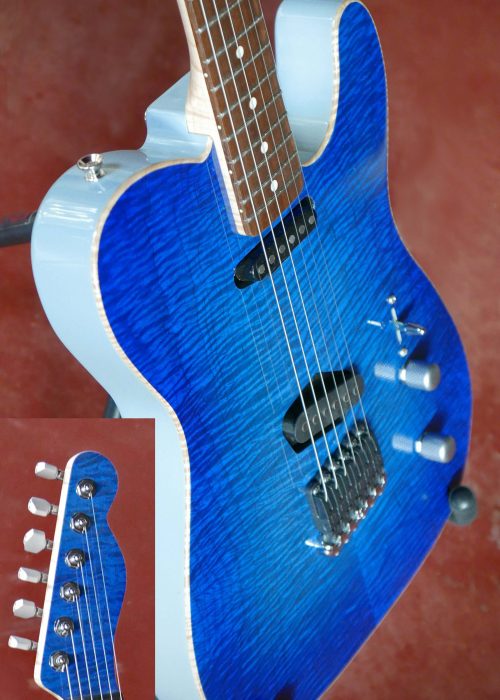 Tony Nobles "Coney Island Custom" Tele Guitar Master luthier Tony Nobles, based in Wimberly, Texas, needs little introduction. He’s been crafting custom guitars for years, quietly, without much hype, for artists ranging in style from Joe Walsh to Alejandro Escovedo. This guitar is fun, unique (it’s one of one), and draws on the DNA of some interesting sources. Starting with: the fretboard is made from rosewood salvaged from the actual Coney Island Boardwalk when they rebuilt it a few years ago. So it's a piece of history. Cut to chase on this unique guitar:
Tony Nobles "Coney Island Custom" Tele Guitar Master luthier Tony Nobles, based in Wimberly, Texas, needs little introduction. He’s been crafting custom guitars for years, quietly, without much hype, for artists ranging in style from Joe Walsh to Alejandro Escovedo. This guitar is fun, unique (it’s one of one), and draws on the DNA of some interesting sources. Starting with: the fretboard is made from rosewood salvaged from the actual Coney Island Boardwalk when they rebuilt it a few years ago. So it's a piece of history. Cut to chase on this unique guitar:- Top: bookmatched Maple; Natural Maple top binding
- Nitrocelulose lacquer finish
- Musikraft neck, maple, with rosewood fretboard made from salvaged wood from the actual Coney Island Boardwalk (when they tore down the old boardwalk for reconstruction, and the wood was preserved by architects/preservationists)
- 25.5" Scale
- Width at the Nut: 1-11/16"
- Width at the Heel: 2-3/16 (55.56mm)
- Number of Frets: 21
- Fret Type: Medium 6105
- Finger Board Radius: 10"
- Back of neck: natural, no finish
- Front of headstock, blue to match body
- Bridge: Schaller, imported from Germany, chrome
- Tuners: Sperzel Trimlok Locking Guitar Tuners 6-in-line Trim-Lok SATIN CHROME
- Volume and tone knobs: brushed satin chrome
- Pickups: Harmonic Design "54 special" for the bridge pickup; and Harmonic Design "MiniStrat" for the neck pickup
-
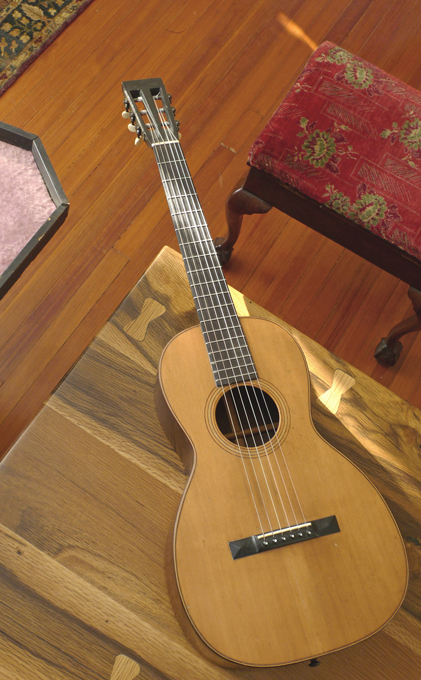 Another all-original pre-war Martin… but you have to go back a few more wars on this one- to just after the Civil War. This guitar even has its original coffin case–necessary in the days when Martin guitars were shipped out by railroad or wagon train. The figured Brazilian rosewood back and sides are unusual– in these decades of the 19th century (and through the middle of the 20th) Martin usually did not use this kind of figured, lovely Brazilian (they preferred the more straight-grained variety). On this guitar, for the sake of originality, we’ve kept its original saddle intact. The original ivory saddle is worn through at the strings, but still functions nicely.
Another all-original pre-war Martin… but you have to go back a few more wars on this one- to just after the Civil War. This guitar even has its original coffin case–necessary in the days when Martin guitars were shipped out by railroad or wagon train. The figured Brazilian rosewood back and sides are unusual– in these decades of the 19th century (and through the middle of the 20th) Martin usually did not use this kind of figured, lovely Brazilian (they preferred the more straight-grained variety). On this guitar, for the sake of originality, we’ve kept its original saddle intact. The original ivory saddle is worn through at the strings, but still functions nicely.- Fan braced
- Adirondack top
- Ebonized “ice cream cone” style neck
- Solid Brazilian rosewood back and sides
- 100% original finish…. No overspray, touch-up, etc. anywhere…wonderful finish
- Original ebony bridge, and bridge plate
- Two cracks in spruce top; one is bridge to bottom of top; the other is from near bridge to soundhole; first one described is beneath an internal brace; second is 2mm adjacent to a different brace. Neither need attention and are left alone to preserve originality.
- Characteristic, three Martin stamps: “CF Martin & Co, New York” ink stamped on neck block; “CF Martin & Co, New York” ink stamped on center strip inside; and “CF Martin New York”, stamped/pressed into brazilian rosewood back of guitar, up near the heel. (note: this guitar is not signed personally by factory foreman, etc, on underside of top…. This fact, and the other details, points to a circa 1870 date, not 1880s or 90’s).
-
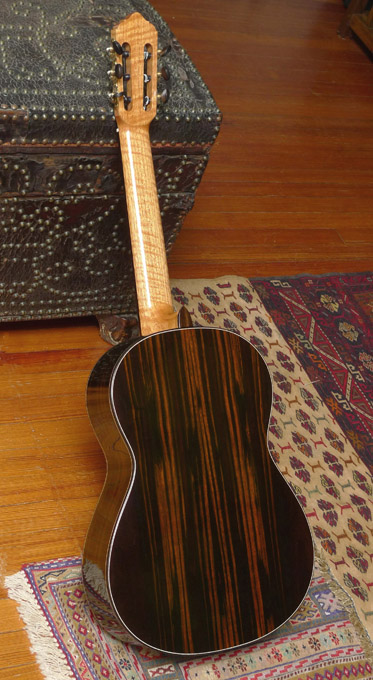 Vustom made Lester Devoe Flamenco Negra, a one-of-a-kind, Brazilian Rosewood guitar, from one of the world’s top luthiers. Lester Devoe needs no introduction to the world’s great Flamenco players. The late, legendary Sabicas played a Devoe– and converted some of the great Flamenco players in Spain to the fold. Paco De Lucia, and Vicente Amigo, among others, play Devoe Flamenco guitars. (I personally delivered a Devoe Flamenco Blanca guitar to Paco De Lucia in Spain in late 2010– Paco likes his Devoe’s hand-delivered. Paco De Lucia began playing a Devoe Negra guitar years ago– and there are many Paco De Lucia recordings and feature films where Paco plays a Devoe Flamenco guitar.) And it’s rare that Lester makes a Negra with Brazilian rosewood of this age and quality.
Vustom made Lester Devoe Flamenco Negra, a one-of-a-kind, Brazilian Rosewood guitar, from one of the world’s top luthiers. Lester Devoe needs no introduction to the world’s great Flamenco players. The late, legendary Sabicas played a Devoe– and converted some of the great Flamenco players in Spain to the fold. Paco De Lucia, and Vicente Amigo, among others, play Devoe Flamenco guitars. (I personally delivered a Devoe Flamenco Blanca guitar to Paco De Lucia in Spain in late 2010– Paco likes his Devoe’s hand-delivered. Paco De Lucia began playing a Devoe Negra guitar years ago– and there are many Paco De Lucia recordings and feature films where Paco plays a Devoe Flamenco guitar.) And it’s rare that Lester makes a Negra with Brazilian rosewood of this age and quality.- 650mm scale length
- Nut: 52mm
- Neck width at nut: 52mm
- String Spacing at nut: 44mm
- 80 year old Brazilian Rosewood (pre-CITES) back and sides (Quartersawn).
- European spruce top, with some beautiful and understated “"hazelfichte" (what Americans call bear claw).
- Custom, flamed Spanish Cedar neck
- Brazilian Rosewood headstock overlay, and bridge
- Brazilian Rosewood body binding, top and back
- Ebony fingerboard
- Sloane tuners
- Austere yet elegant Santos style black and white rosette, that Devoe uses only rarely, on top custom models
- Nitrocellulose lacquer finish
-
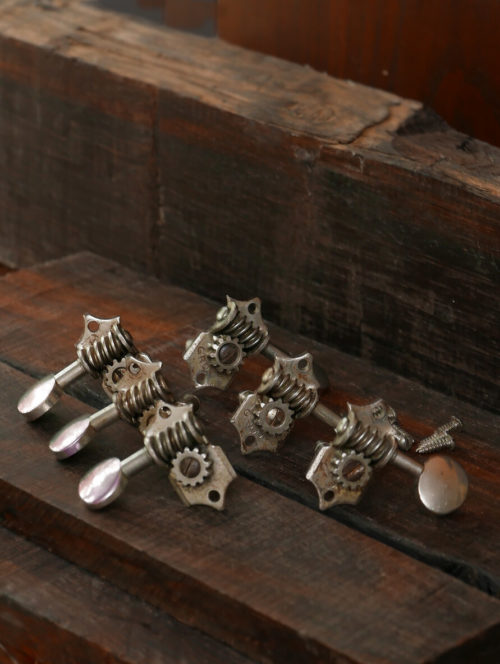 6:1 ratio pre war Grovers, mid-1930's. As used on Martin pre-war dreadoaught guitars. Oval buttons, bevelled edges on the baseplate. Just one button has some missing chrome on one side (see photos). With bushings, and mounting screws. No bent shafts. Good working condition. Price: $795.
6:1 ratio pre war Grovers, mid-1930's. As used on Martin pre-war dreadoaught guitars. Oval buttons, bevelled edges on the baseplate. Just one button has some missing chrome on one side (see photos). With bushings, and mounting screws. No bent shafts. Good working condition. Price: $795. -
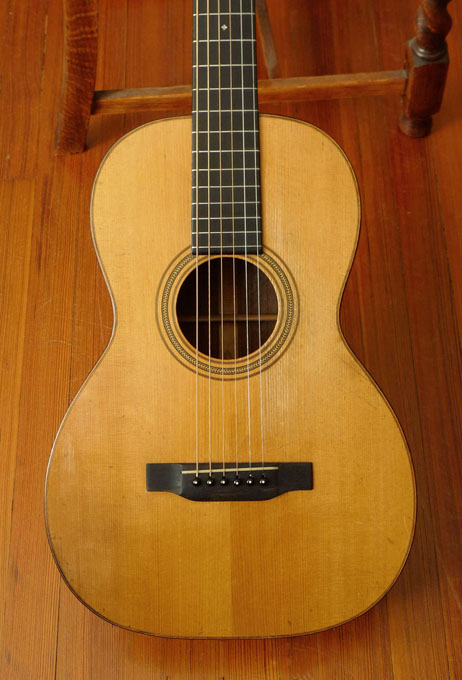 This is a wonderful Martin 0-21, but with “the best of both worlds”: the light build of 1924– combined with 1930’s robust, “braced for steel” construction. It left the factory in 1924, but it went back to Martin in 1934 for a neck set, new belly bridge, and to get set up fully for steel strings. Details below.
This is a wonderful Martin 0-21, but with “the best of both worlds”: the light build of 1924– combined with 1930’s robust, “braced for steel” construction. It left the factory in 1924, but it went back to Martin in 1934 for a neck set, new belly bridge, and to get set up fully for steel strings. Details below.- All original finish
- Original 1934 bridge, and bridge plate from Martin Factory
- Original saddle
- Original “arrowhead” design tuners. The first Waverly tuners showed up in 1924/25 and remained until after the war. The arrowhead design, seen here on the tuner plates, showed up also in 1924, still with the shafts placed underneath the gears / string posts.
- Crack free (there is one cleat inside guitar, on upper bout, back. There is no visible crack that goes through wood to inside, just a tiny finish crack on outside. No doubt the Martin luthier place the cleat there in 1934 as a preventative measure (that worked).
- The combination of the original thin-profile neck, with the braced-for-steel modifications by Martin factory in 1934, make for a very robust guitar– you can play it hard and it holds up and projects like a 30’s Martin.
- Sold by Martin factory and shipped to Rudolph Wurlitzer Co. in Chicago on March 18, 1924. (This guitar does not have “Wulitzer” stamps, rather the normal CF Martin Stamps in all the correct places. This is consistent with Martin/Wurlitzer timetable in “Martin Guitars: A Technical Reference” by Johnston and Boak, 2009, p. 248.)
- June 20, 1933: the owner wrote to Martin that instrument needed a neck set and the bridge was “adrift”. Martin replied on June 23 that the normal guarantee would probably cover this work.
- Owner sent the guitar to Martin on July 3, 1934. Martin reported back to owner on July 16 that readjusting the neck and regluing the bridge would be covered by the warranty, Martin also offered a “new” bridge (meaning belly bridge) for $1.50. Martin also said that some binding could be reglued and repaired for $3.00.
- Work done at Martin, July 1934. The luthier at Martin replaced the bridge with a 1934 spec ebony belly bridge, and replaced the bridge plate with a perfect, tucked, small maple bridge plate. Martin luthier signs underside of spruce top: "7-25-1934”, and put his initials (“W.T.W.”), right by the edge of the X-brace to the top/upper bout. Of course, the back was taken off the guitar to do the above work. But being perfectly done at Martin factory in 1934, there are no visible signs of that– back binding is perfect.
- Total repair bill from Martin factory in 1934: $4.50. Paid by check, and Martin return ships the 0-21 to owner on August 15th, 1934.
-
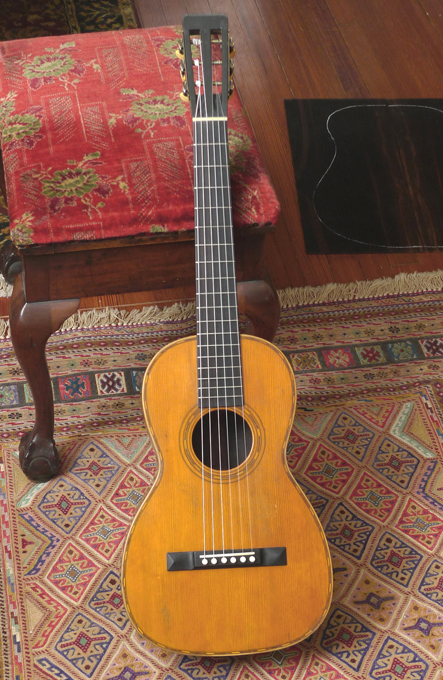 A rare, wonderfully-preserved, 1854 Schmidt & Maul. It’s signed and dated inside: Louis Schmidt Tompkinsville Staten Island New York 388 Broadway August 18th 1854 U. S.
A rare, wonderfully-preserved, 1854 Schmidt & Maul. It’s signed and dated inside: Louis Schmidt Tompkinsville Staten Island New York 388 Broadway August 18th 1854 U. S.- Adirondack top
- Ebonized “ice cream cone” style neck
- solid brazilian rosewood back and sides
- fan braced
- marquetry Purfling around top, with Maple binding
- Maple binding, back
- Width at lower bout: 11 ½ inches
- 100% original finish. No overspray, touch-up, etc. anywhere…wonderful finish
- Not a crack on top, or sides. One small dryness crack on back, near the edge binding on treble side
- Original bridge plate, in great condition
- Reproduction, correct, Ebony bridge
- Bar frets replaced with period correct Bar frets from TJ Thompson
-
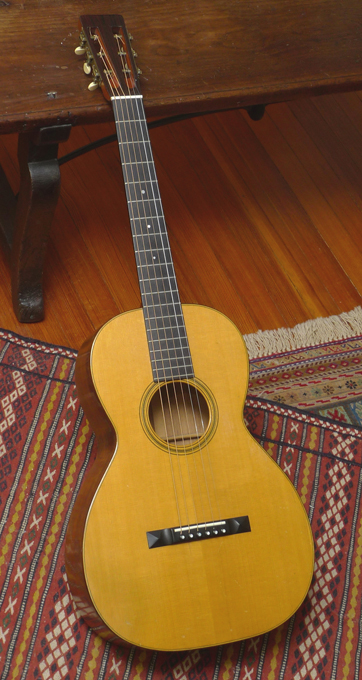 The grandson of Martin Guitar founder C. F. Martin, Sr., Frank Henry Martin suddenly found himself in control of the family business at the age of 22 when his father died in 1888 and left him unexpectedly in charge. The guitar market was still immature, and the young country was headed into an economic panic in the 1890's, but the young Frank Henry Martin quickly turned a traditional German business close to bankruptcy into a major force in the world of American music. Along with the young Frank Martin’s now legendary work ethic and marketing acumen, he is credited with personally revamping the Martin model line-up at the turn of the new century. Eschewing the trappings of an executive, he literally worked along side the shop craftsmen, day in and day out, six days a week. And he made the Style 18 the mainstay of the Martin catalog. This instrument is a living testament to that legacy– he personally signed this instrument, in cursive, under the top, on the fourth of February, 1907: “ 10381 2/4/07 F.H.M. ” Martin was still using Brazilian Rosewood for the back and sides for their 0-18 model in this 1907, and the tone of this instrument reflects all that is great about the combination of Brazilian back and sides, and Adirondack spruce (top), with a cedar neck, on the perennially great Size 0 Martin 12-fret, in all its Brazilian rosewood permutations through two centuries. This guitar is in remarkably original condition, and is completely crack-free. Just a few minor dings and superficial scratches. The finish is 100% original, with no touch-ups of any kind. The bar frets were replaced by us with period-correct bar frets–with material obtained from T.J. Thomson. (Several frets were missing, so we decided to replace all the frets.) Original ivory saddle, and bridge pins. Bridge has never been off the guitar. At some time in the past a neck set was done, so action is great, and the neck is straight. Original ebony nut is in the case. An ivory nut is installed on the guitar to accommodate silk & steel strings–which it does wonderfully. An Adirondack/Brazilian 12-fret 0-sized Martin over a century old yet in this kind of original condition, is very rare.
The grandson of Martin Guitar founder C. F. Martin, Sr., Frank Henry Martin suddenly found himself in control of the family business at the age of 22 when his father died in 1888 and left him unexpectedly in charge. The guitar market was still immature, and the young country was headed into an economic panic in the 1890's, but the young Frank Henry Martin quickly turned a traditional German business close to bankruptcy into a major force in the world of American music. Along with the young Frank Martin’s now legendary work ethic and marketing acumen, he is credited with personally revamping the Martin model line-up at the turn of the new century. Eschewing the trappings of an executive, he literally worked along side the shop craftsmen, day in and day out, six days a week. And he made the Style 18 the mainstay of the Martin catalog. This instrument is a living testament to that legacy– he personally signed this instrument, in cursive, under the top, on the fourth of February, 1907: “ 10381 2/4/07 F.H.M. ” Martin was still using Brazilian Rosewood for the back and sides for their 0-18 model in this 1907, and the tone of this instrument reflects all that is great about the combination of Brazilian back and sides, and Adirondack spruce (top), with a cedar neck, on the perennially great Size 0 Martin 12-fret, in all its Brazilian rosewood permutations through two centuries. This guitar is in remarkably original condition, and is completely crack-free. Just a few minor dings and superficial scratches. The finish is 100% original, with no touch-ups of any kind. The bar frets were replaced by us with period-correct bar frets–with material obtained from T.J. Thomson. (Several frets were missing, so we decided to replace all the frets.) Original ivory saddle, and bridge pins. Bridge has never been off the guitar. At some time in the past a neck set was done, so action is great, and the neck is straight. Original ebony nut is in the case. An ivory nut is installed on the guitar to accommodate silk & steel strings–which it does wonderfully. An Adirondack/Brazilian 12-fret 0-sized Martin over a century old yet in this kind of original condition, is very rare. -
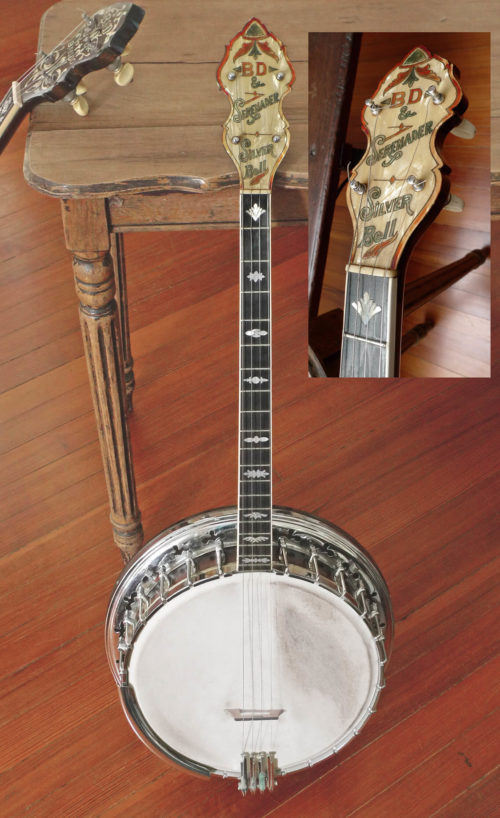 This 1922 Bacon & Day Serenader, tenor banjo is in great original condition. The well-worn head can be easily replaced– we retained it for originality. The banjo shows little wear. And all the parts are original–Tailpiece, tuners, dowel, everything. This is a golden era B&D, not one of the later 30s/40's banjos that are more common. In this condition it is rare. And it comes in its original hard shell case. Price: $1695.
This 1922 Bacon & Day Serenader, tenor banjo is in great original condition. The well-worn head can be easily replaced– we retained it for originality. The banjo shows little wear. And all the parts are original–Tailpiece, tuners, dowel, everything. This is a golden era B&D, not one of the later 30s/40's banjos that are more common. In this condition it is rare. And it comes in its original hard shell case. Price: $1695. -
 The Larson Brothers need little introduction to the world’s top players and collectors, and they are very different instruments from the Martin and Gibson instruments that dominated the 1920’s and 30’s by their shear numbers. Larson instruments are rising in value rapidly, as they never produced the kind of volume that Martin much less Gibson produced in those decades, and they are now recognized for their magnificent workmanship and tone. The now legendary Chicago-based Larson brothers, August and Carl, did not make instruments with a “Larson” label. All of their instruments were branded and marketed for Stahl, Maurer, Prairie State, Euphonon, Dyer, Bruno, and a few more. Yet every one of their instruments has their unmistakable trademarks. And their unmistakable tone. This exquisitely beautiful, 100% original Larson Mandolin was made at the very height of the Larson legacy– when they were making their finest instruments. It has all of the Larson trademarks that set apart the best Larsons, including “built under tension” design, and Larson’s classic “ebony under the binding” on the neck. Every part of this instrument is 100% original. And its crack-free– save for two tiny dryness finish cracks near center of back, of about two inches each.
The Larson Brothers need little introduction to the world’s top players and collectors, and they are very different instruments from the Martin and Gibson instruments that dominated the 1920’s and 30’s by their shear numbers. Larson instruments are rising in value rapidly, as they never produced the kind of volume that Martin much less Gibson produced in those decades, and they are now recognized for their magnificent workmanship and tone. The now legendary Chicago-based Larson brothers, August and Carl, did not make instruments with a “Larson” label. All of their instruments were branded and marketed for Stahl, Maurer, Prairie State, Euphonon, Dyer, Bruno, and a few more. Yet every one of their instruments has their unmistakable trademarks. And their unmistakable tone. This exquisitely beautiful, 100% original Larson Mandolin was made at the very height of the Larson legacy– when they were making their finest instruments. It has all of the Larson trademarks that set apart the best Larsons, including “built under tension” design, and Larson’s classic “ebony under the binding” on the neck. Every part of this instrument is 100% original. And its crack-free– save for two tiny dryness finish cracks near center of back, of about two inches each.- 100% original finish, everywhere
- Scale length: 13 inches
- Nut width: 1 1/8 inches
- Serial number: 38764
-
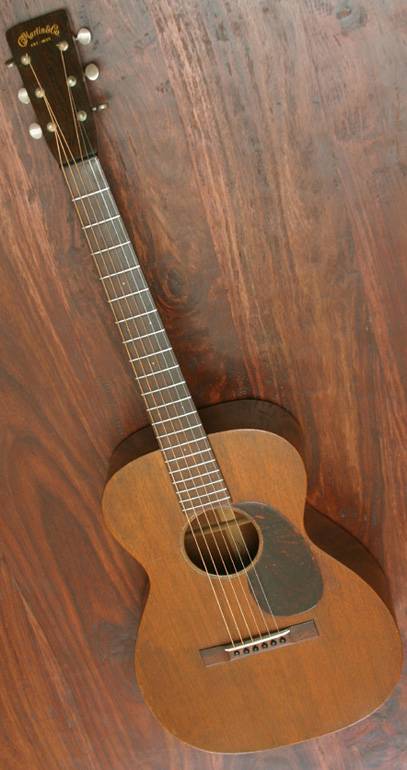 It’s rare to find a Golden Era Martin in this condition. This wonderful, completely crack-free 14-fret guitar from the 30’s is a gem. It’s one of the very first Martins of any style to have all three: 14 frets clear of body+Martin decal on the front of the peghead+Martin stamp the back of the peghead. Mahogany top, back and sides, of course, and it has the great, resonant feel and tone of a very lightly built 12-fret, but with more volume, in a 14-fret package. Strong bass response. 1 3/4 inch nut. Original finish, everywhere; no cracks anywhere. Original tuners. Original full-height bridge and maple bridge plate. Original bridge pins, and nut. The neck was recently set, so there is a new bone saddle, and the action is nice and low. Original bar frets. Some slight wear below the pick guard (not a hint of a crack or even any shrinking of the edges of the pick guard), and a variety of minor dings– but this completely crack-free guitar from the Martin Golden era is a gem.
It’s rare to find a Golden Era Martin in this condition. This wonderful, completely crack-free 14-fret guitar from the 30’s is a gem. It’s one of the very first Martins of any style to have all three: 14 frets clear of body+Martin decal on the front of the peghead+Martin stamp the back of the peghead. Mahogany top, back and sides, of course, and it has the great, resonant feel and tone of a very lightly built 12-fret, but with more volume, in a 14-fret package. Strong bass response. 1 3/4 inch nut. Original finish, everywhere; no cracks anywhere. Original tuners. Original full-height bridge and maple bridge plate. Original bridge pins, and nut. The neck was recently set, so there is a new bone saddle, and the action is nice and low. Original bar frets. Some slight wear below the pick guard (not a hint of a crack or even any shrinking of the edges of the pick guard), and a variety of minor dings– but this completely crack-free guitar from the Martin Golden era is a gem. -
Out of stock
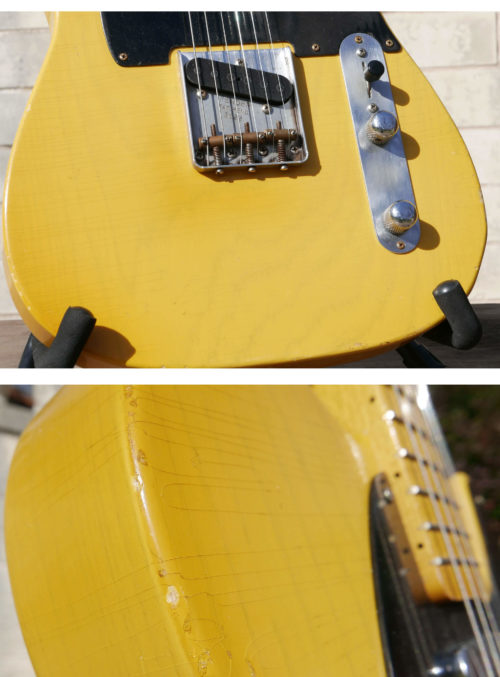 This could be the best blackguard telecaster tribute ever. An homage to the great early 50’s telecaster. But it only gets accolades if it’s a great player. This one is a great player–its light weight (same weight range as on original early 50s telecaster), pickups, setup, and attention to detail make for a great sounding tele. A joy to play. There appear to be a few original 1952/1953 parts on this guitar– but this guitar is being offered strictly as a reproduction/tribute. And it’s a tribute, in its way, to the art of the (great) copy– and on that note, it comes with Nacho Baños’ great book, The Blackguard book (out of print and a $300-400 value in itself), with matching serial number on the cover of the book. (Click here for a story on Baños.) So the purchaser can follow along the narrative of some of the great original early Blackguards in the book–and how to identify original early 50’s Telecaster, Nocaster, and Esquire elements and parts– while having fun with this intriguing tribute guitar. • The bridge, a good reproduction of unknown origin. The photos tell the story. (Original early 50’s brass saddles?). Reproduction tuners. • The pickguard looks convincing, but we're calling it a reproduction. • Seymour Duncan Antiquity pickups. • The pots, and the pickup switch, appear to be original 1952 or 1953 Fender parts (but not with original solder joints etc). • The control plate appears to be an original 1952/1953 Fender plate. Tone, volume knobs are (good) reproductions. • Neck is from Mark Jenny, stamped on heel as official Fender “Licensed” neck. Medium C profile. Great feel– not baseball bat, and not too thin. • Weight, with strings: 6.625 lbs. This is in the same weight range as original early 50s telecasters. Compare to the weight of mediocre telecaster “reissues” on the market today, all of which weigh much more. • The body is by Mark Jenny. We waited patiently for over a year until the right Jenny body became available, to complete this instrument in the best way possible and to remove from the market the (nice light weight) reproduction body that was in place when we acquired the guitar that had a non-authentic 1952 date and signature in the neck pocket. The right thing to do– and the Mark Jenny body in place now has crazing and other elements characteristic to the early blackguard look, weight, wear, and feel. • Set up perfectly, and ready to play. Sold as a reproduction/tribute guitar only, together with the Nacho Baños The Blackguard book (book in as-new condition in original box) that will school the new owner on how to evaluate the fine, fully pedigreed, great Blackguards of the early 50’s. Price: $5950.
This could be the best blackguard telecaster tribute ever. An homage to the great early 50’s telecaster. But it only gets accolades if it’s a great player. This one is a great player–its light weight (same weight range as on original early 50s telecaster), pickups, setup, and attention to detail make for a great sounding tele. A joy to play. There appear to be a few original 1952/1953 parts on this guitar– but this guitar is being offered strictly as a reproduction/tribute. And it’s a tribute, in its way, to the art of the (great) copy– and on that note, it comes with Nacho Baños’ great book, The Blackguard book (out of print and a $300-400 value in itself), with matching serial number on the cover of the book. (Click here for a story on Baños.) So the purchaser can follow along the narrative of some of the great original early Blackguards in the book–and how to identify original early 50’s Telecaster, Nocaster, and Esquire elements and parts– while having fun with this intriguing tribute guitar. • The bridge, a good reproduction of unknown origin. The photos tell the story. (Original early 50’s brass saddles?). Reproduction tuners. • The pickguard looks convincing, but we're calling it a reproduction. • Seymour Duncan Antiquity pickups. • The pots, and the pickup switch, appear to be original 1952 or 1953 Fender parts (but not with original solder joints etc). • The control plate appears to be an original 1952/1953 Fender plate. Tone, volume knobs are (good) reproductions. • Neck is from Mark Jenny, stamped on heel as official Fender “Licensed” neck. Medium C profile. Great feel– not baseball bat, and not too thin. • Weight, with strings: 6.625 lbs. This is in the same weight range as original early 50s telecasters. Compare to the weight of mediocre telecaster “reissues” on the market today, all of which weigh much more. • The body is by Mark Jenny. We waited patiently for over a year until the right Jenny body became available, to complete this instrument in the best way possible and to remove from the market the (nice light weight) reproduction body that was in place when we acquired the guitar that had a non-authentic 1952 date and signature in the neck pocket. The right thing to do– and the Mark Jenny body in place now has crazing and other elements characteristic to the early blackguard look, weight, wear, and feel. • Set up perfectly, and ready to play. Sold as a reproduction/tribute guitar only, together with the Nacho Baños The Blackguard book (book in as-new condition in original box) that will school the new owner on how to evaluate the fine, fully pedigreed, great Blackguards of the early 50’s. Price: $5950. -
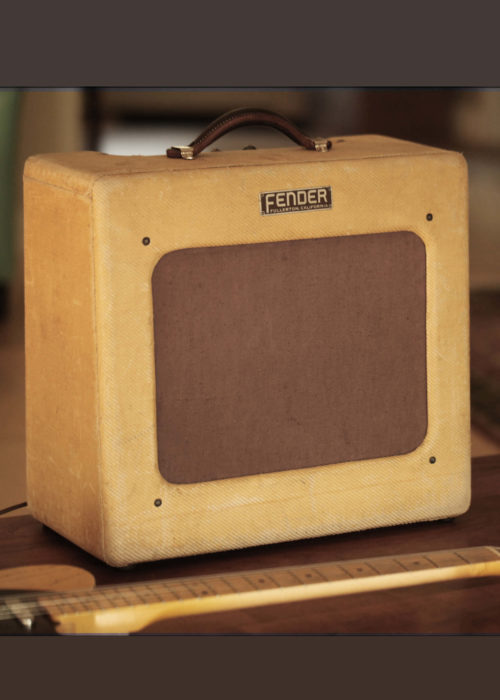 1951 Fender Deluxe Amplifier ... all it should be, and more... coming soon... . .
1951 Fender Deluxe Amplifier ... all it should be, and more... coming soon... . .